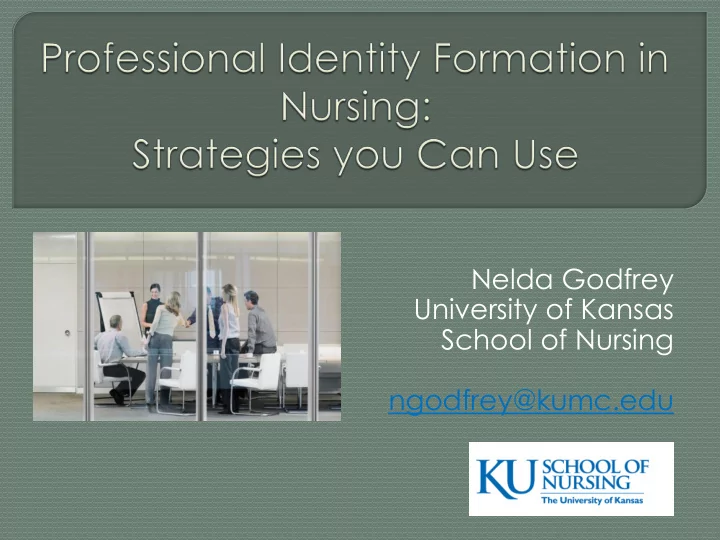

Nelda Godfrey University of Kansas School of Nursing ngodfrey@kumc.edu
4. Shift from an emphasis on socialization and role taking to an emphasis on formation .
Novice Competent Proficient Expert Mastery Non situated Situated Situated Situated Situated recollection recollection recollection recollection recollection Decomposed Decomposed Wholistic Wholistic Wholistic recognition recognition recognition recognition recognition Analytic Analytic Analytic Intuitive Intuitive decision- decision- decision- decision- decision- making making making making making Monitoring Monitoring Monitoring Monitoring Absorbed awareness awareness awareness awareness awareness Dreyfus Model of Skill Acquisition https://www.youtube.com/watch?v=3tSWWaFnsF8
Professional Identity Professional Identity Development Professional Identity Formation
1900s to 1960s to 2000 -- 1950s 2000 present • Virtue • Virtue + • Behaviorist based Behaviorist (competency) approaches (competency) approaches + emerging dominated identities
ACGME (US) Patient care Medical knowledge Practice based learning and improvement Interpersonal and communication skills Professionalism Systems-based practice
Cruess, R. & Cruess, S. (2009). Professionalism. CanMEDS Train the Trainer Program.
1870s to 1960s to Next?? 1950s present day • Virtue + • Virtue • Behaviorist Behaviorist based (competency) (competency) approaches approaches + identity dominate formation?
Professional Identity Professional Identity Development Professional Identity Formation
Mental Health Professionals Family Systems Educators Physical Therapy Dietitians Occupational Therapy Pharmacy Advanced Practice Nurses Nursing Paramedics Medicine Genetic Counselors Social Work Veterinary Medicine Undergraduate Students Psychologists Alumni Physician Assistants
BIG PICTURE: Topic is poorly addressed in higher education literature (Trede & Macklin, 2012) Review of professional identity in registered nurses did not yield enough articles for review (Rasmussen, et al., 2018) Very few theoretically based studies to guide researchers and educators (Roberts & Kumar, 2015) Professional identity of the nurse concept analysis completed (Ohlen & Segesten, 1998)
Key components for optimizing professional identity/professional identity formation: • Experiential learning (9) • Longitudinal curriculum (10) • Pedagogical innovations (8) • Mindfulness and reflection (4) • Make values explicit (3) • Move past negative implications of hidden curriculum (3)
Key components for optimizing professional identity/professional identity formation: • Organization in teaching counts (3) • Good role models make all the difference (2) • Quality clinical experiences (3) • Clarity of professional identity (2) • Develop a personal commitment (1) • A focus on self care (1) • Create a sense of belonging (1)
Key Findings: • Professional identity is a developmental phenomenon (Jebril 2008) • Burnout decreases with a professional identity development program ( Sabancıogullari & Dogan, 2015) • Tensions can destabilize professional identity in difficult patient care areas (Dadich, et al., 2014)) • Professional identity and self-concept appear to be linked (Tinkler, et al., 2018)
Key Findings: • 11 research articles reported professional identity formation as a positive outcome of the research • No instruments yet exist that measure professional identity with confidence (Cowin, et al., 2013) • A focus on professional identity increased empathy scores (Schweller, et al., 2017)
Many professions are identifying issues and approaches to forming and fostering professional identity Specific strategies are present in the literature — though less for practice than education Generally patient care benefits from a strong professional identity
Other disciplines are developing language and strategies to form and foster professional identity. 2010 Carnegie report recommendations affirm the need for nursing to do the same. It is time to develop the language and start setting the course in nursing, informed by practice, education and regulation
Beal and Riley, 2015
Margaret Wheatley
Beal, J. & Riley, JM (2015). The Development of a Clinical Nurse Scholar in Baccalaureate Education. Journal of Professional Nursing, 31 (5), 379-387. Cowin, L., Johnson, M., Wilson, I & Borgese, K. (2013). The psychometric properties of five Professional Identity measures in a sample of nursing students. Nurse Education Today, 33 (6), 608-613. Dadich, A., Jarrett, C., Robards, F., & Bennett, D. (2015). How professional identity shapes youth healthcare. J Health Organ Manag, 29(3), 317-342. doi:10.1108/jhom-06-2012-0096 Schweller M, Ribeiro DL, Celeri EV, de Carvalho-Filho MA. (2017). Nurturing virtues of the medical profession: does it enhance medical students' empathy? Int J Med Educ. 2017 Jul 11;8:262-267. doi: 10.5116/ijme.5951.6044. Tinkler, L., Smith, V., Yiannakou, Y., & Robinson, L. (2018). Professional identity and the Clinical Research Nurse: A qualitative study exploring issues having an impact on participant recruitment in research. Journal of Advanced Nursing, 74(2), 318-328. doi:10.1111/jan.13409 Sabancıogullari , S., & Dogan, S. (2015). Effects of the professional identity development programme on the professional identity, job satisfaction and burnout levels of nurses: A pilot study. International Journal of Nursing Practice, 21(6), 847-857. doi:10.1111/ijn.12330
Recommend
More recommend